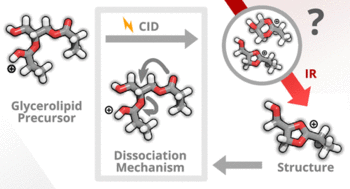Unveiling Glycerolipid Fragmentation by Cryogenic Infrared Spectroscopy
Kirschbaum, C.; Greis, K.; Polewski, L.; Gewinner, S.; Schöllkopf, W.; Meijer, G.; von Helden, G.; Pagel, K.* – 2021
Mass spectrometry is routinely employed for structure elucidation of molecules. Structural information can be retrieved from intact molecular ions by fragmentation; however, the interpretation of fragment spectra is often hampered by poor understanding of the underlying dissociation mechanisms. For example, neutral headgroup loss from protonated glycerolipids has been postulated to proceed via an intramolecular ring closure but the mechanism and resulting ring size have never been experimentally confirmed. Here we use cryogenic gas-phase infrared (IR) spectroscopy in combination with computational chemistry to unravel the structures of fragment ions and thereby shed light on elusive dissociation mechanisms. Using the example of glycerolipid fragmentation, we study the formation of protonated five-membered dioxolane and six-membered dioxane rings and show that dioxolane rings are predominant throughout different glycerolipid classes and fragmentation channels. For comparison, pure dioxolane and dioxane ions were generated from tailor-made dehydroxyl derivatives inspired by natural 1,2- and 1,3-diacylglycerols and subsequently interrogated using IR spectroscopy. Furthermore, the cyclic structure of an intermediate fragment occurring in the phosphatidylcholine fragmentation pathway was spectroscopically confirmed. Overall, the results contribute substantially to the understanding of glycerolipid fragmentation and showcase the value of vibrational ion spectroscopy to mechanistically elucidate crucial fragmentation pathways in lipidomics.





